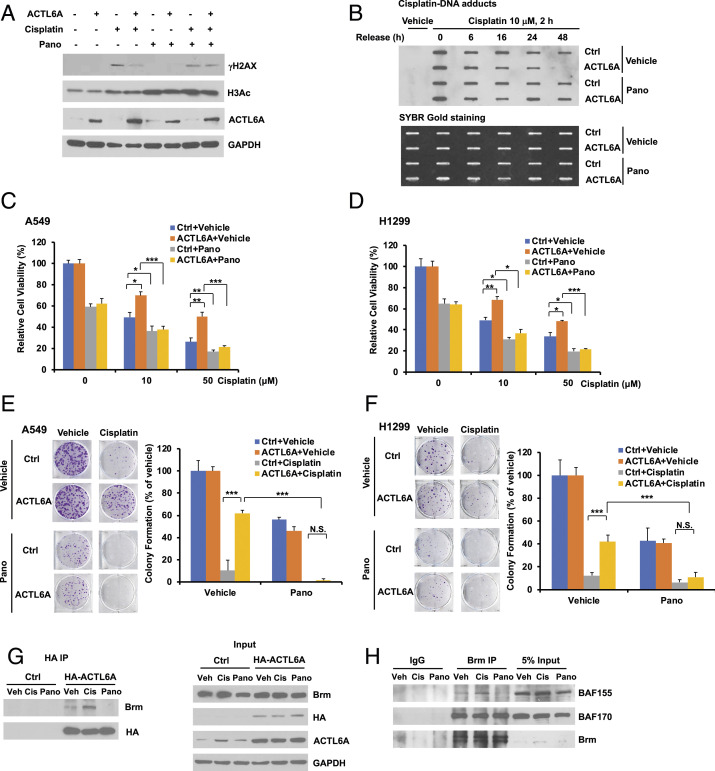Fig. 7.
Panobinostat abolishes cisplatin resistance caused by ACTL6A overexpression through the destabilization of the SWI/SNF complex. (A) Panobinostat treatment mitigates the inhibitory effect of ACTL6A on cisplatin-induced H2AX activation. H1299 cells stably overexpressing an empty vector or ACTL6A were treated with 100 nM panobinostat and/or 10 μM cisplatin for 24 h. The whole cell lysates were subjected to Western blot analysis to determine the levels of phosphorylated H2AX (γH2AX) or acetyl Histone H3 (H3Ac). (B) Panobinostat blocks the effect of ACTL6A on enhancing DNA repair after cisplatin treatment. Control or ACTL6A-overexpressing H1299 cells were treated with 10 μM cisplatin and/or 100 nM panobinostat for 2 h. After release and culture in fresh medium for various times as indicated, slot blot analysis was performed using an anti-cisplatin-DNA adducts antibody to determine the DNA repair. (C and D) Panobinostat blocks the effect of ACTL6A on promoting cell viability after cisplatin treatment. A549 (C) or H1299 (D) cells stably overexpressing an empty vector or ACTL6A were treated with vehicle or cisplatin (10 or 50 μM) in the absence or presence of 100 nM panobinostat for 48 h. Cell viability was determined by MTT assay. (E and F) Stable A549 (E) or H1299 (F) cells as described above were treated with 1 μM cisplatin and/or 20 nM panobinostat for 24 h. After washing, cells were cultured in fresh medium until colonies were formed. Representative images are shown on the Left. For cell viability assay, data shown represent the mean ± SD from at least three or four biological replicates. For colony formation assay, data shown represent the mean ± SD from at least three independent experiments. *P < 0.05, **P < 0.01, and ***P < 0.001. (G) Panobinostat treatment blocks ACTL6A binding to Brm. H1299 cells stably expressing an empty vector or HA-ACTL6A were treated with vehicle (Veh), 10 μM cisplatin (Cis), or 100 nM panobinostat (Pano) for 24 h. Coimmunoprecipitation was performed by immunoprecipitating HA-ACTL6A with anti-HA monoclonal antibody-conjugated agarose, followed by immunoblotting using an anti-Brm rabbit antibody or an anti-HA antibody. (H) Panobinostat blocks the recruitment of BAF155 but not BAF170, to the Brm complex. H1299 cells were treated with 10 μM cisplatin or 100 nM panobinostat for 24 h. Coimmunoprecipitation of endogenous Brm with BAF155 or BAF170 was performed as described in Fig. 6E.

